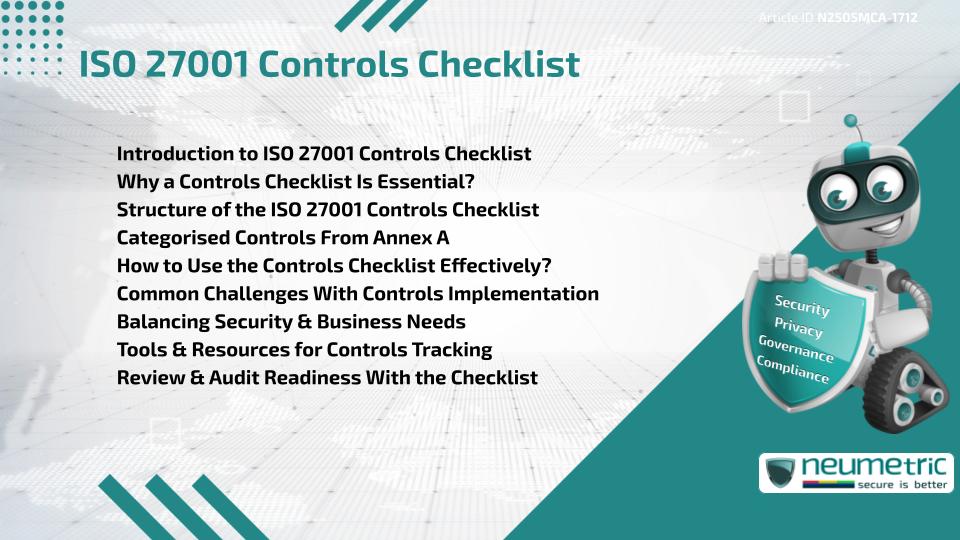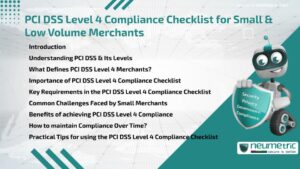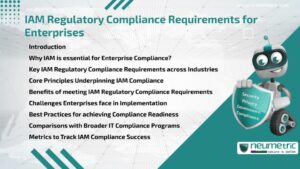Table of Contents
ToggleIntroduction to ISO 27001 Controls Checklist
ISO 27001 provides a comprehensive set of practices to manage information security. However, putting the Annex A controls into practical use can often seem overwhelming. A clear ISO 27001 controls checklist breaks these requirements into manageable steps so teams can ensure compliance without getting lost in detail.
This article explains what goes into the checklist why it matters & how to apply it. It also explores potential tradeoffs & ways to keep things practical.
Why a Controls Checklist Is Essential?
A controls checklist offers a clear path from theory to practice. It helps organisations track which controls are relevant, how they are implemented & where gaps remain. That makes implementation transparent & audit-ready.
Without a checklist organisations may miss important controls or struggle to prove their security measures. A structured checklist supports both internal alignment & external validation, making ISO 27001 feel less abstract & more actionable.
Structure of the ISO 27001 Controls Checklist
A typical ISO 27001 controls checklist maps controls to clauses & includes status indicators. It often includes:
- Control ID & description
- Implementation status (planned or in place)
- Owner & implementation date
- Evidence or documentation references
- Notes on residual risks
This format turns Annex A’s abstract list into a practical work plan. You can find sample checklists at the National Cyber Security Centre & in public templates from standards bodies.
Categorised Controls From Annex A
Annex A includes controls across logical categories. A controls checklist groups these for clarity:
A.5–A.6: Policy & Organisation
These controls ensure an information security policy exists & roles are defined.
A.7–A.8: Human Resources & Asset Management
These cover staff background checks, training & asset classification.
A.9: Access Control
These define user access processes & privilege management.
A.10–A.11: Cryptography & Physical Security
These involve encryption standards & physical access controls.
A.12–A.18: Operations to Supplier Relationships
These handle incident response supplier contracts system acquisition & compliance management.
Separating controls by category helps assign ownership & monitor progress.
How to Use the Controls Checklist Effectively?
Using an ISO 27001 controls checklist well involves several practical steps:
- Tailor the checklist to reflect your organisation’s scope size & risk profile.
- Carry out a gap assessment to evaluate how well current practices align with the required controls.
- Assign control ownership to individuals or teams.
- Collect evidence such as policies, procedures or logs for each control.
- Regularly check progress through internal audits or Information Security Management System [ISMS] review meetings.
- Update the checklist to reflect changes in risk systems or operations.
Effective use of the checklist ensures that your ISMS remains aligned with both ISO 27001 & business needs.
Common Challenges With Controls Implementation
Applying a controls checklist reveals common issues:
- Misaligned controls:When controls fail to match actual operational practices, this failure can cause issues or deficiencies during audits.
- Overloaded teams: Control owners might not have sufficient time to oversee or revise the controls.
- Document gaps: Evidence may be missing or scattered in various systems.
- Changing scope: Rapid changes in services may leave controls outdated.
Understanding these obstacles enables teams to develop workable strategies & avoid unforeseen problems down the line.
Balancing Security & Business Needs
Implementing every control may slow operations or add costs. A controls checklist allows organisations to:
- Identify critical controls that deliver necessary protection
- Plan lightweight or automated alternatives for less critical areas
- Make decisions based on risk tolerance & resource availability
This balances compliance with efficiency & reduces resistance from busy teams.
Tools & Resources for Controls Tracking
You don’t need expensive platforms to maintain a ISO 27001 controls checklist. Consider:
- Spreadsheet templates that group controls by category
- Document libraries for storing evidence in one place
- Internal audit guides for verifying control implementation
- Training modules that help owners understand their responsibilities
- Gap analysis checklists to track missing controls & actions
Non-commercial resources like the NCSC toolkit & standards body templates provide solid foundations.
Review & Audit Readiness With the Checklist
A controls checklist stays most effective when reviewed regularly. This includes:
- Checking control status quarterly or during ISMS meetings.
- Conduct internal audits to confirm supporting evidence & pinpoint areas that need improvement.
- Updating controls after system changes incidents or external feedback.
- Keeping track of updates with clear version history & change logs.
A well maintained checklist ensures readiness for internal reviews & certification audits alike.
Takeaways
- An ISO 27001 controls checklist turns Annex A into actionable steps
- It tracks implementation status evidence ownership & gaps
- Grouping controls by category improves clarity & monitoring
- Using checklist supports balanced security & business priorities
- Consistent reviews & regular audits support the continued effectiveness of the ISMS.
FAQ
What is the ISO 27001 controls checklist?
It is a tool that lists Annex A controls with implementation status evidence & ownership to track progress.
How many controls are there in total inside the ISO 27001 controls checklist?
There are ninety-four (94) Annex A controls that need review & potential implementation.
Who should own each control on the checklist?
Control ownership should be given to individuals or teams with responsibility or influence over that area.
How often should the controls checklist be updated?
It should be updated whenever risks systems or processes change & reviewed at least annually.
Can small organisations use the control checklist?
Yes. Organisations of any size can adapt the checklist to their risk profile & scale controls accordingly.
How does the checklist help during audits?
It provides a clear map of which controls are implemented where evidence is stored & who is responsible for reducing audit time.
Is evidence required for every control?
Yes. For each implemented control you need documented evidence such as policies logs or procedure records.
Need help?
Neumetric provides organisations the necessary help to achieve their Cybersecurity, Compliance, Governance, Privacy, Certifications & Pentesting goals.
Organisations & Businesses, specifically those which provide SaaS & AI Solutions, usually need a Cybersecurity Partner for meeting & maintaining the ongoing Security & Privacy needs & requirements of their Clients & Customers.
SOC 2, ISO 27001, ISO 42001, NIST, HIPAA, HECVAT, EU GDPR are some of the Frameworks that are served by Fusion – a centralised, automated, AI-enabled SaaS Solution created & managed by Neumetric.
Reach out to us!





